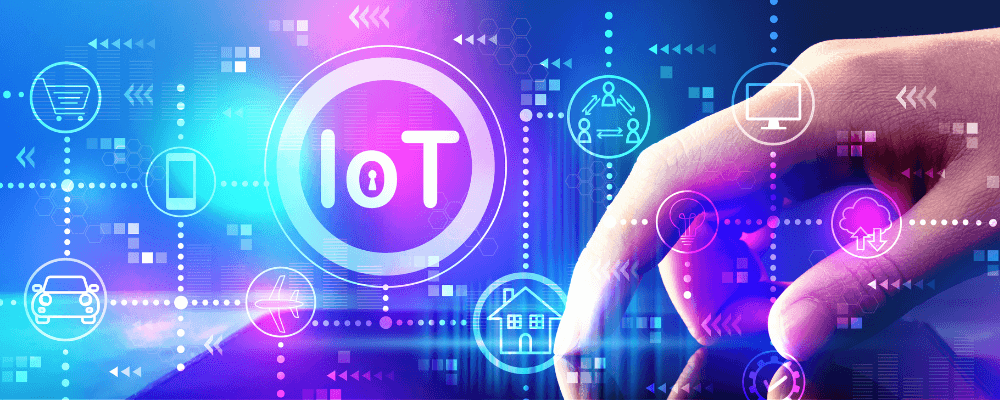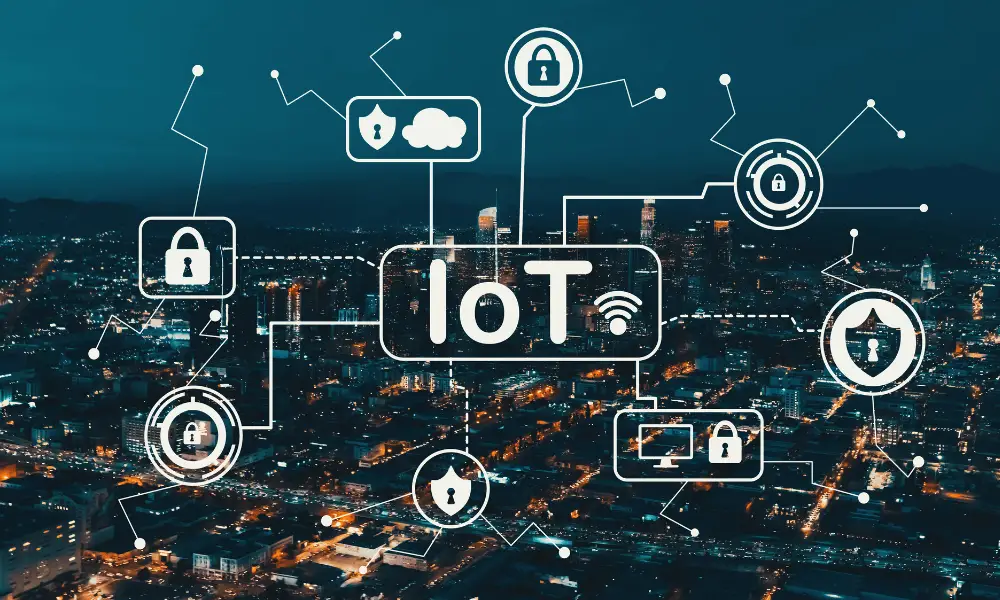The Internet of Things (IoT) pertains to thousands of physical devices. These devices are now interconnected with the internet and gather and share information worldwide. It is turning the world brighter and more adaptive by fusing the physical and digital worlds. There are a lot of benefits of IoT that are impacting the world.
Business sectors are progressively utilizing IoT to function more effectively and better understand consumers. It helps them provide better customer support, enhance decision-making, and raise the performance of the businesses. There will be over 10 billion users using IoT app ideas and IoT devices in 2021, with a projected increase to 25.4 billion by 2030. In this article, we will discuss how IoT relinks different sectors in the world.
How Does the Internet of Things (IoT) Work?
An IoT environment comprises web-enabled connected devices that employ embedded systems, including sensors, processors, and communication hardware, to gather, transmit, and respond to information from their surroundings.
Internet of Things devices exchanges sensor data by linking to an IoT network or other edge device. Here, data is either transferred to the cloud for processing locally. These gadgets occasionally connect with other connected devices and respond to information they receive from each other.
The gadgets conduct most tasks without human interaction, while individuals may engage with them to line them up, offer them directions, or display the information.
Related: How 5G Networks and IoT Will Power Smart Cities of the Future
Main Benefits of Internet of Things (IoT)
The benefits of IoT have altered how businesses handle the usage of gadgets in the workforce. In today’s digital world, gadgets, and machines, of various sizes may automatically send data across a network. So, let’s discuss some of the necessary benefits of how IoT assists businesses:
1. Accessibility and Control
You may obtain the necessary information promptly from any place. All you need is a smart gadget and internet access. Some mobile app ideas have also made things easier for people today. For instance, you can use Google Maps to get your position instead of contacting someone in person.
In addition, purchasing tickets is now easier than before. Data is also readily available, including the most recent scientific research and commercial analyses.
2. Adapting to New Standards
There are several established standards and conventions that are directly tied to building the ecosystem required for a thriving IoT, highlighting the importance of the IoT to business and the advantages that technological innovation offers to the general public.
The following are some significant standards activities:
- Architectural framework
- IoT harmonization and security
- Sensor Quality and Performance
- Cost-cutting
The more organizations that employ Internet of Things gadgets to enhance organizational performance and boost profitability, the more IoT technology will be targeted to assist those firms in flourishing.
For instance, cloud computing is a very effective technique to reduce corporate costs. Cloud computing lowers labor costs and eliminates the concern of hardware costs, allowing your company to expand quickly and effectively.
3. Rapid Functioning
IoT, for instance, enables simple automation. Conversely, smart companies automate tedious processes, allowing people to devote effort and time to more difficult jobs.
OPPO, for example, has set up a pre-research unit to do a preliminary study on 6G service and innovation. 6G, according to OPPO, will change the way people engage with AI. Smart gadgets will become important players and users of AI, downloading and installing AI algorithms at various application levels.

Main Impacts of Internet of Things on Our Lives and Society
We have been begun to see how IoT may help improve our world. It has come to be viewed as a technique that digitizes the physical environment.
The Internet of Things will transform the way we operate by reducing the cost and time while also creating opportunities for development and creativity through computers in education and other areas. To claim this statement, we would like to state the best four ways IoT relinks today’s world.
1. Impact of IoT on Cities (Smart Cities)
Cities currently house over half of the worldwide people. But, according to the United Nations, that proportion might reach 66% by mid-century. As a result, cities are excellent accelerators for IoT-based technologies that improve urban living, such as rapid, easy transit systems, secure street lighting, and power-efficient structures.
IoT technologies for smart cities include smart monitoring, automation transport, water distribution, improved power management, urban security, and environmental control.
IoT will alleviate fundamental difficulties that city dwellers confront, such as traffic congestion, pollution, and a lack of energy supply, among other things. For example, individuals may identify free parking spaces throughout the city by placing sensors and utilizing online apps or mobile app ideas.
Smart cities that use IoT mix applications, structures, and systems to provide more effective working and living settings. Better connection and accessibility to the city’s characteristics are important priorities. The overall budget for smart city technologies is approximately $679.5 billion, with a considerable increase projected in parking and improved energy controls.
Some Advantages of IoT in Smart Cities:
- With the help of modern technologies, IoT smart cities can effortlessly redirect congested traffic.
- Individuals use their smart gadgets to connect to the IoT (IoT) in smart cities. They can know when public transportation is available, examine directions, and even park their automobiles using their smartphones.
- Another benefit is better communication. Corporations use the IoT in novel ways to keep their employees informed about what is happening around the city and the enterprise.
Related: IoT Powered Smart LED Lighting – Benefits, Opportunities, and Use Cases
2. Impact of IoT on Healthcare
Remote management in the healthcare industry has become feasible because of IoT-enabled devices that unlock the tendency to maintain patients’ health and safety while allowing clinicians to provide exceptional care. Furthermore, as contacts with physicians have gotten simpler and more convenient, it has also boosted patient satisfaction.
Furthermore, remote management of a patient’s condition decreases hospital visits and avoids re-admissions. Therefore, IoT in healthcare has a huge influence on lowering healthcare expenses and increasing treatment results.
The Internet of Things is undeniably revolutionizing the healthcare business by expanding the area of gadgets and providing quality healthcare.
IoT has applications that assist individuals, relatives, doctors, institutions, and insurance firms in healthcare. As the use of IoT apps in healthcare expands and develops, healthcare institutions are getting more advanced, providing optimal clinical outcomes, and positive work environments for all healthcare professionals.
Increased gadgets and information provide fresh insights on medical surroundings, patient care, and new treatment options. Data access enables clinicians to uncover trends and find new kinds of clinical treatment that were formerly hard to comprehend and use.
Some Benefits of utilizing IoT in Healthcare Facilities:
- IoT security technologies improve patient, doctor, and all staff safety.
- Improved patient comfort level leads to higher patient outcomes and shorter recovery periods.
- IoT-based healthcare gadgets, wearable technologies, healthcare IoT app ideas, and data access enable clinicians to track patients more precisely and give more effective therapy.
Related: What Impact Will the IoT Have on Healthcare Sector?
3. Impact of IoT on Agriculture
With the world’s growing population at an alarming rate, the need for food is skyrocketing. Authorities are assisting farmers in increasing food production by applying new technology and research.
Smart agriculture is one of the most rapidly growing areas of IoT. Farmers are leveraging significant data insights to improve their financial returns.
Some basic applications of IoT include monitoring soil moisture, managing water consumption for plant development, and deciding on custom fertilizer.
IoT technology has the potential to help agriculture and farming significantly. Smart technology allows farmers and agricultural employees to watch crops and their livestock better, evaluate data on farm supplies, and use drone technology to inspect the land.
Precision agriculture is the pinnacle of all of these improvements. With the need for food on the rise, IoT innovations will assist agricultural workers in keeping up.
Some Advantages of Using IoT in the Agricultural Sector:
- Farmers can evaluate their crops and surroundings in real-time using IoT-enabled agriculture.
- Precision agriculture with IoT is based on data received from various sensors in the field, allowing farmers to distribute sufficient resources precisely.
- The use of IoT in agriculture improves process adaptability.
4. Impact on IoT on Manufacturing
The increasing necessity for automation, proactive maintenance, and centralized monitoring is propelling IoT technology to the forefront of the manufacturing sector.
Manufacturers are intensifying their quest for the Internet of Things in response to concerns such as sudden epidemics, calamities, and disputes.
They intend to stay innovative and prepare better for corporate growth by using IoT.
The IoT impact on manufacturing will dramatically reduce production costs by lowering waste, fuel usage, and the dumping of financially unsustainable assets; It can also increase energy production and transmission effectiveness and cut emissions by aiding the transition of renewables.
The industry is benefiting from the use and IoT impact on manufacturing. Including its data-driven approaches, it is revolutionizing the industrial industry and ushering in a technological age throughout industries.
Manufacturers have always demanded customization, increased productivity, and functionality. The introduction of IoT has had the greatest influence on the manufacturing industries compared to other sectors.
Some Advantages of Using IoT in Manufacturing:
- The IoT technology monitors machinery in real-time and delivers accurate information to make better decisions. In addition, it helps to improve the corporate strategy to make them more customer-centric. As a result, IoT influences the growing income of your manufacturing company.
- The beneficial effects of IoT are creating a revolutionary trail that only raises the sector’s potential.
- With the aid of sensing devices, IoT fills the gap among resources and their efficiency.
Conclusion
The future of the Internet of Things is more intriguing when human participation is reduced to a minimum. The Internet of Things will cause a significant change in how we work and live.
We hope that this post explaining the four ways IoT helps the globe perform successfully has provided you with all the necessary information.
There are several other sectors where IoT has an influence. It’s up to humans how they can use and manage IoT in different sectors.





